A Compact Accelerator-Based Light Source for High-Power, Full-Bandwidth Tunable Coherent THz Generation
Abstract
:Featured Application
Abstract
1. Introduction
2. Method and Principles
3. Results
3.1. Generation of Frequency Beating Laser Pulse
3.2. Performance of the THz Radiation with Undulator at 11.5 THz and 23 THz
3.3. Performance of the THz Radiation with Undulator at 30 THz and 60 THz
3.4. Performance with Three Dimensional Effects
4. Discussion and Conclusions
Author Contributions
Funding
Institutional Review Board Statement
Informed Consent Statement
Data Availability Statement
Acknowledgments
Conflicts of Interest
References
- Tonouchi, M. Cutting-edge terahertz technology. Nat. Photonics 2007, 1, 97–105. [Google Scholar] [CrossRef]
- Shen, Y.; Watanabe, T.; Arena, A.; Kao, C.-C.; Murphy, J.B.; Tsang, T.Y.; Wang, X.J.; Carr, G.L. Nonlinear Cross-Phase Modulation with Intense Single-Cycle Terahertz Pulses. Phys. Rev. Lett. 2007, 99, 043901. [Google Scholar] [CrossRef] [PubMed]
- Gaal, P.; Kuehn, W.; Reimann, K.; Woerner, M.; Elsaesser, T.; Hey, R. Internal motions of a quasiparticle governing its ultrafast nonlinear response. Nature 2007, 450, 1210–1213. [Google Scholar] [CrossRef] [PubMed]
- LaRue, J.; Katayama, T.; Lindenberg, A.; Fisher, A.S.; Öström, H.; Nilsson, A.; Ogasawara, H. THz-Pulse-Induced Selective Catalytic CO Oxidation on Ru. Phys. Rev. Lett. 2015, 115, 036103. [Google Scholar] [CrossRef] [PubMed] [Green Version]
- Mittleman, D.M. Twenty years of terahertz imaging [Invited]. Opt. Express 2018, 26, 9417–9431. [Google Scholar] [CrossRef]
- Kovács, K.; Balogh, E.; Hebling, J.; Tosa, V.; Varjú, K. Quasi-Phase-Matching High-Harmonic Radiation Using Chirped THz Pulses. Phys. Rev. Lett. 2012, 108, 193903. [Google Scholar] [CrossRef] [Green Version]
- Stojanovic, N.; Drescher, M. Accelerator- and laser-based sources of high-field terahertz pulses. J. Phys. B At. Mol. Opt. Phys. 2013, 46, 192001. [Google Scholar] [CrossRef]
- Fülöp, J.A.; Ollmann, Z.; Lombosi, C.; Skrobol, C.; Klingebiel, S.; Pálfalvi, L.; Krausz, F.; Karsch, S.; Hebling, J. Efficient generation of THz pulses with 04 mJ energy. Opt. Express 2014, 22, 20155–20163. [Google Scholar] [CrossRef] [PubMed]
- Vicario, C.; Ovchinnikov, A.V.; Ashitkov, S.I.; Agranat, M.B.; Fortov, V.E.; Hauri, C.P. Generation of 0.9-mJ THz pulses in DSTMS pumped by a Cr:Mg₂SiO₄ laser. Opt. Lett. 2014, 39, 6632–6635. [Google Scholar] [CrossRef]
- Shalaby, M.; Hauri, C.P. Demonstration of a low-frequency three-dimensional terahertz bullet with extreme brightness. Nat. Commun. 2015, 6, 5976. [Google Scholar] [CrossRef] [Green Version]
- Vicario, C.; Monoszlai, B.; Hauri, C.P. GV/mSingle-Cycle Terahertz Fields from a Laser-Driven Large-Size Partitioned Organic Crystal. Phys. Rev. Lett. 2014, 112, 213901. [Google Scholar] [CrossRef] [Green Version]
- Leemans, W.P.; Geddes, C.G.R.; Faure, J.; Tóth, C.; van Tilborg, J.; Schroeder, C.B.; Esarey, E.; Fubiani, G.; Auerbach, D.; Marcelis, B.; et al. Observation of Terahertz Emission from a Laser-Plasma Accelerated Electron Bunch Crossing a Plasma-Vacuum Boundary. Phys. Rev. Lett. 2003, 91, 074802. [Google Scholar] [CrossRef] [PubMed] [Green Version]
- Clerici, M.; Peccianti, M.; Schmidt, B.E.; Caspani, L.; Shalaby, M.; Giguère, M.; Lotti, A.; Couairon, A.; Légaré, F.; Ozaki, T.; et al. Wavelength Scaling of Terahertz Generation by Gas Ionization. Phys. Rev. Lett. 2013, 110, 253901. [Google Scholar] [CrossRef] [Green Version]
- Kim, K.-Y.; Taylor, A.J.; Glownia, J.H.; Rodriguez, G. Coherent control of terahertz supercontinuum generation in ultrafast laser–gas interactions. Nat. Photonics 2008, 2, 605–609. [Google Scholar] [CrossRef]
- Gopal, A.; Herzer, S.; Schmidt, A.; Singh, P.; Reinhard, A.; Ziegler, W.; Brömmel, D.; Karmakar, A.; Gibbon, P.; Dillner, U.; et al. Observation of Gigawatt-Class THz Pulses from a Compact Laser-Driven Particle Accelerator. Phys. Rev. Lett. 2013, 111, 074802. [Google Scholar] [CrossRef] [PubMed]
- Liao, G.-Q.; Li, Y.-T.; Zhang, Y.-H.; Liu, H.; Ge, X.-L.; Yang, S.; Wei, W.-Q.; Yuan, X.-H.; Deng, Y.-Q.; Zhu, B.-J.; et al. Demonstration of Coherent Terahertz Transition Radiation from Relativistic Laser-Solid Interactions. Phys. Rev. Lett. 2016, 116, 205003. [Google Scholar] [CrossRef] [Green Version]
- Liao, G.; Li, Y.; Liu, H.; Scott, G.G.; Neely, D.; Zhang, Y.; Zhu, B.; Zhang, Z.; Armstrong, C.D.; Zemaityte, E.; et al. Multimillijoule coherent terahertz bursts from picosecond laser-irradiated metal foils. Proc. Natl. Acad. Sci. USA 2019, 116, 3994–3999. [Google Scholar] [CrossRef] [PubMed] [Green Version]
- Abo-Bakr, M.; Feikes, J.; Holldack, K.; Wüstefeld, G. Steady-State Far-Infrared Coherent Synchrotron Radiation detected at BESSY II. Phys. Rev. Lett. 2002, 88, 254801. [Google Scholar] [CrossRef]
- Byrd, J.M.; Leemans, W.P.; Loftsdottir, A.; Marcelis, B.; Martin, M.C.; McKinney, W.R.; Sannibale, F.; Scarvie, T.; Steier, C. Observation of Broadband Self-Amplified Spontaneous Coherent Terahertz Synchrotron Radiation in a Storage Ring. Phys. Rev. Lett. 2002, 89, 224801. [Google Scholar] [CrossRef] [Green Version]
- Bielawski, S.; Evain, C.; Hara, T.; Hosaka, M.; Katoh, M.; Kimura, S.; Mochihashi, A.; Shimada, M.; Szwaj, C.; Takahashi, T.; et al. Tunable Narrowband Terahertz Emission from Mastered Laser–Electron Beam Interaction. Nat. Phys. 2008, 4, 390–393. [Google Scholar] [CrossRef]
- Zhang, Z.; Fisher, A.S.; Hoffmann, M.C.; Jacobson, B.; Kirchmann, P.S.; Lee, W.-S.; Lindenberg, A.; Marinelli, A.; Nanni, E.; Schoenlein, R.; et al. A High-Power, High-Repetition-Rate THz Source for Pump–Probe Experiments at Linac Coherent Light Source II. J. Synchrotron Radiat. 2020, 27, 890–901. [Google Scholar] [CrossRef]
- Di Mitri, S.; Perucchi, A.; Adhlakha, N.; Di Pietro, P.; Nicastro, S.; Roussel, E.; Spampinati, S.; Veronese, M.; Allaria, E.; Badano, L.; et al. Coherent THz Emission Enhanced by Coherent Synchrotron Radiation Wakefield. Sci. Rep. 2018, 8, 11661. [Google Scholar] [CrossRef] [Green Version]
- Yang, X.; Brunetti, E.; Gil, D.R.; Welsh, G.; Li, F.; Cipiccia, S.; Ersfeld, B.; Grant, D.W.; Grant, P.A.; Islam, M.R.; et al. Three Electron Beams from a Laser-Plasma Wakefield Accelerator and the Energy Apportioning Question. Sci. Rep. 2017, 7, 43910. [Google Scholar] [CrossRef] [PubMed] [Green Version]
- Wu, Z.; Fisher, A.S.; Goodfellow, J.; Fuchs, M.; Daranciang, D.; Hogan, M.; Loos, H.; Lindenberg, A. Intense terahertz pulses from SLAC electron beams using coherent transition radiation. Rev. Sci. Instruments 2013, 84, 022701. [Google Scholar] [CrossRef] [PubMed]
- Daranciang, D.; Goodfellow, J.; Fuchs, M.; Wen, H.; Ghimire, S.; Reis, D.A.; Loos, H.; Fisher, A.S.; Lindenberg, A.M. Single-Cycle Terahertz Pulses with >0.2 V/Å Field Amplitudes via Coherent Transition Radiation. Appl. Phys. Lett. 2011, 99, 141117. [Google Scholar] [CrossRef] [Green Version]
- Green, B.; Kovalev, S.; Asgekar, V.; Geloni, G.; Lehnert, U.; Golz, T.; Kuntzsch, M.; Bauer, C.; Hauser, J.; Voigtlaender, J.; et al. High-Field High-Repetition-Rate Sources for the Coherent THz Control of Matter. Sci. Rep. 2016, 6, 22256. [Google Scholar] [CrossRef] [PubMed]
- Tanaka, T. Difference frequency generation in free electron lasers. Opt. Lett. 2018, 43, 4485–4488. [Google Scholar] [CrossRef] [PubMed]
- Tanikawa, T.; Karabekyan, S.; Kovalev, S.; Casalbuoni, S.; Asgekar, V.; Serkez, S.; Geloni, G.; Gensch, M. A superradiant THz undulator source for XFELs. J. Instrum. 2019, 14, P05024. [Google Scholar] [CrossRef] [Green Version]
- Liang, L.; Liu, W.; Jia, Q.; Wang, L.; Lu, Y. High-harmonic terahertz Smith-Purcell free-electron-laser with two tandem cylindrical-gratings. Opt. Express 2017, 25, 2960–2968. [Google Scholar] [CrossRef]
- Bonifacio, R.; Pellegrini, C.; Narducci, L. Collective instabilities and high-gain regime in a free electron laser. Opt. Commun. 1984, 50, 373–378. [Google Scholar] [CrossRef] [Green Version]
- Andruszkow, J.; Aune, B.; Ayvazyan, V.; Baboi, N.; Bakker, R.; Balakin, V.; Barni, D.; Bazhan, A.; Bernard, M.; Bosotti, A.; et al. First Observation of Self-Amplified Spontaneous Emission in a Free-Electron Laser at 109 nm Wavelength. Phys. Rev. Lett. 2000, 85, 3825–3829. [Google Scholar] [CrossRef] [PubMed] [Green Version]
- Huang, Z.; Kim, K.-J. Review of x-ray free-electron laser theory. Phys. Rev. Spéc. Top. Accel. Beams 2007, 10, 034801. [Google Scholar] [CrossRef]
- Tiedtke, K.; Azima, A.; Von Bargen, N.; Bittner, L.; Bonfigt, S.; Düsterer, S.; Faatz, B.; Frühling, U.; Gensch, M.; Gerth, C.; et al. The soft x-ray free-electron laser FLASH at DESY: Beamlines, diagnostics and end-stations. N. J. Phys. 2009, 11, 023029. [Google Scholar] [CrossRef]
- Li, Y.; Kim, K.-J. Nonrelativistic electron bunch train for coherently enhanced terahertz radiation sources. Appl. Phys. Lett. 2008, 92, 014101. [Google Scholar] [CrossRef]
- Shen, Y.; Yang, X.; Carr, G.L.; Hidaka, Y.; Murphy, J.B.; Wang, X. Tunable Few-Cycle and Multicycle Coherent Terahertz Radiation from Relativistic Electrons. Phys. Rev. Lett. 2011, 107, 204801. [Google Scholar] [CrossRef]
- Liu, W.; Lu, Y.; He, Z.; Li, W.; Wang, L.; Jia, Q. Broad-tunable terahertz source with over-mode waveguide driven by train of electron bunches. Opt. Express 2016, 24, 4109–4116. [Google Scholar] [CrossRef] [PubMed]
- Muggli, P.; Yakimenko, V.; Babzien, M.; Kallos, E.; Kusche, K.P. Generation of Trains of Electron Microbunches with Adjustable Subpicosecond Spacing. Phys. Rev. Lett. 2008, 101, 054801. [Google Scholar] [CrossRef]
- Sun, Y.-E.; Piot, P.; Johnson, A.; Lumpkin, A.H.; Maxwell, T.J.; Ruan, J.; Thurman-Keup, R. Tunable Subpicosecond Electron-Bunch-Train Generation Using a Transverse-To-Longitudinal Phase-Space Exchange Technique. Phys. Rev. Lett. 2010, 105, 234801. [Google Scholar] [CrossRef] [PubMed] [Green Version]
- Zhang, Z.; Yan, L.; Du, Y.; Zhou, Z.; Su, X.; Zheng, L.; Wang, D.; Tian, Q.; Wang, W.; Shi, J.; et al. Tunable High-Intensity Electron Bunch Train Production Based on Nonlinear Longitudinal Space Charge Oscillation. Phys. Rev. Lett. 2016, 116, 184801. [Google Scholar] [CrossRef]
- Antipov, S.; Babzien, M.; Jing, C.; Fedurin, M.; Gai, W.; Kanareykin, A.; Kusche, K.; Yakimenko, V.; Zholents, A. Subpicosecond Bunch Train Production for a Tunable mJ Level THz Source. Phys. Rev. Lett. 2013, 111, 134802. [Google Scholar] [CrossRef] [PubMed]
- Xiang, D.; Stupakov, G. Enhanced tunable narrow-band THz emission from laser-modulated electron beams. Phys. Rev. Spéc. Top. Accel. Beams 2009, 12, 080701. [Google Scholar] [CrossRef] [Green Version]
- Dunning, M.; Hast, C.; Hemsing, E.; Jobe, K.; McCormick, D.; Nelson, J.; Raubenheimer, T.O.; Soong, K.; Szalata, Z.; Walz, D.; et al. Generating periodic terahertz structures in a relativistic electron beam through frequency down-conversion of optical lasers. Phys. Rev. Lett. 2012, 109, 074801. [Google Scholar] [CrossRef] [PubMed] [Green Version]
- Zhang, Z.; Yan, L.; Du, Y.; Huang, W.; Tang, C.; Huang, Z. Generation of high-power, tunable terahertz radiation from laser interaction with a relativistic electron beam. Phys. Rev. Accel. Beams 2017, 20, 050701. [Google Scholar] [CrossRef] [Green Version]
- Zhang, H.; Wang, W.; Jiang, S.; Li, C.; He, Z.; Zhang, S.; Jia, Q.; Wang, L.; He, D. Tuning electron bunch with a longitudinally shaped laser to generate half-cycle terahertz radiation pulse. J. Instrum. 2021, 16, P08019. [Google Scholar] [CrossRef]
- Kan, K.; Huang, Z.; Marcus, G.; Zhang, Z. Intense THz source based on laser modulator and bunch compressor with electron beam ranging from 35 to 50 MeV. Nonlinear Dyn. Collect. Eff. Part. Beam Phys. 2019, 285–297. [Google Scholar] [CrossRef] [Green Version]
- Aniruddha, S.; Weling, S.; Auston, D.H. Novel sources and detectors for coherent tunable narrow-band terahertz radiation in free space. J. Opt. Soc. Am. 1996, 13, 2783–2791. [Google Scholar]
- Xiang, D.; Stupakov, G. Echo-enabled harmonic generation free electron laser. Phys. Rev. Spéc. Top. Accel. Beams 2009, 12, 030702. [Google Scholar] [CrossRef] [Green Version]
- Wigner, E. On the Quantum Correction for Thermodynamic Equilibrium. Phys. Rev. 1932, 40, 749–759. [Google Scholar] [CrossRef]
- Gase, R. The Wigner distribution function applied to laser radiation. Opt. Quantum Electron. 1992, 24, S1109–S1118. [Google Scholar] [CrossRef]
- Available online: http://tesla.desy.de/~meykopff/ (accessed on 13 December 2021).
- Zeng, L.; Feng, C.; Wang, X.; Zhang, K.; Qi, Z.; Zhao, Z. A Super-Fast Free-Electron Laser Simulation Code for Online Optimization. Photonics 2020, 7, 117. [Google Scholar] [CrossRef]
- Reiche, S. GENESIS 1.3: A fully 3D time-dependent FEL simulation code. Nucl. Instrum. Methods Phys. Res. Sect. A Accel. Spectrometers, Detect. Assoc. Equip. 1999, 429, 243–248. [Google Scholar] [CrossRef]
- Ferrario, M.; Alesini, D.; Bacci, A.; Bellaveglia, M.; Boni, R.; Boscolo, M.; Castellano, M.; Chiadroni, E.; Cianchi, A.; Cultrera, L.; et al. Experimental Demonstration of Emittance Compensation with Velocity Bunching. Phys. Rev. Lett. 2010, 104, 054801. [Google Scholar] [CrossRef] [PubMed]
- Borland, M. Elegant: A flexible SDDS-Compliant Code for Accelerator Simulation; Argonne National Lab: Lemont, IL, USA, 2000.
- Zhou, X.; Lee, H.; Kanai, T.; Adachi, S.; Watanabe, S. An 11-fs, 5-kHz optical parametric/Ti:sapphire hybrid chirped pulse amplification system. Appl. Phys. B. 2007, 89, 559–563. [Google Scholar] [CrossRef]

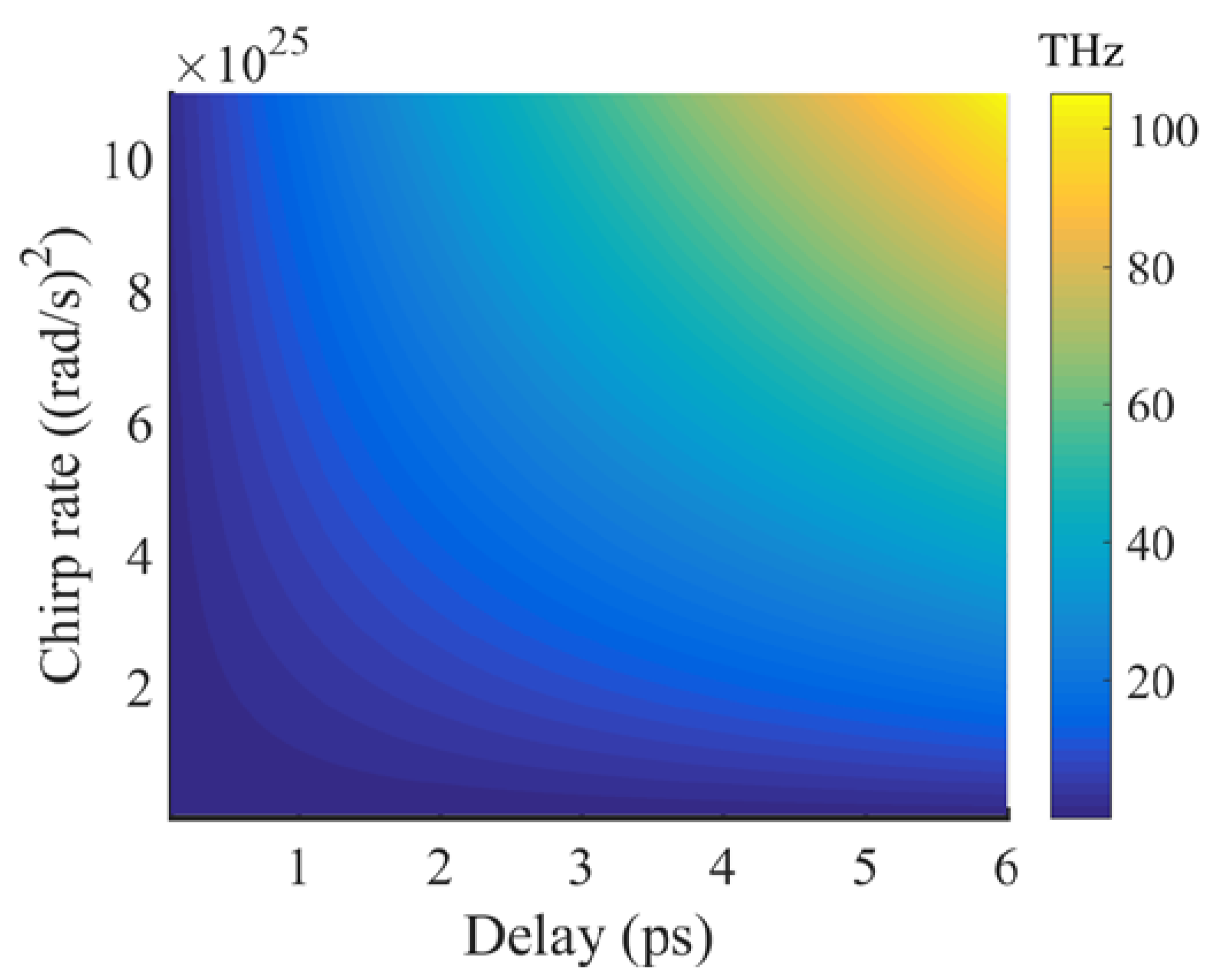
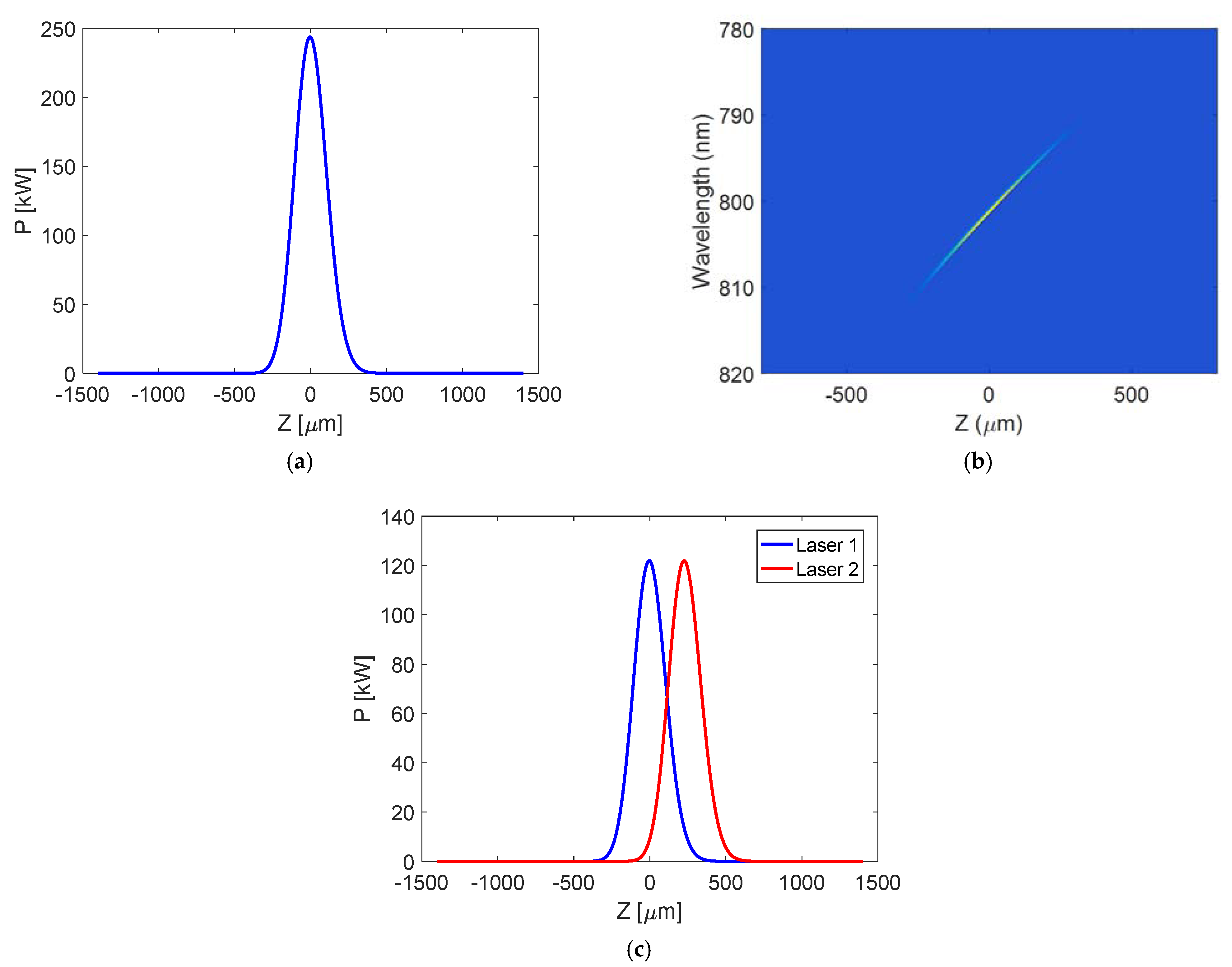



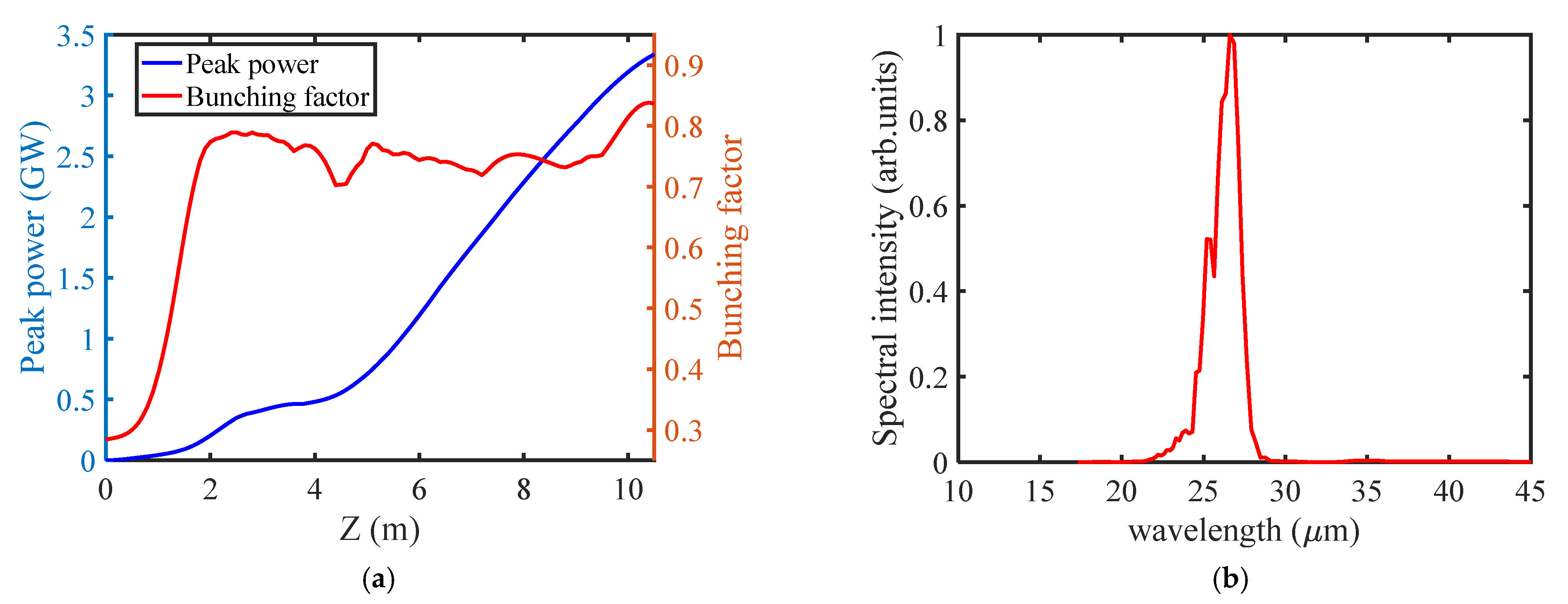
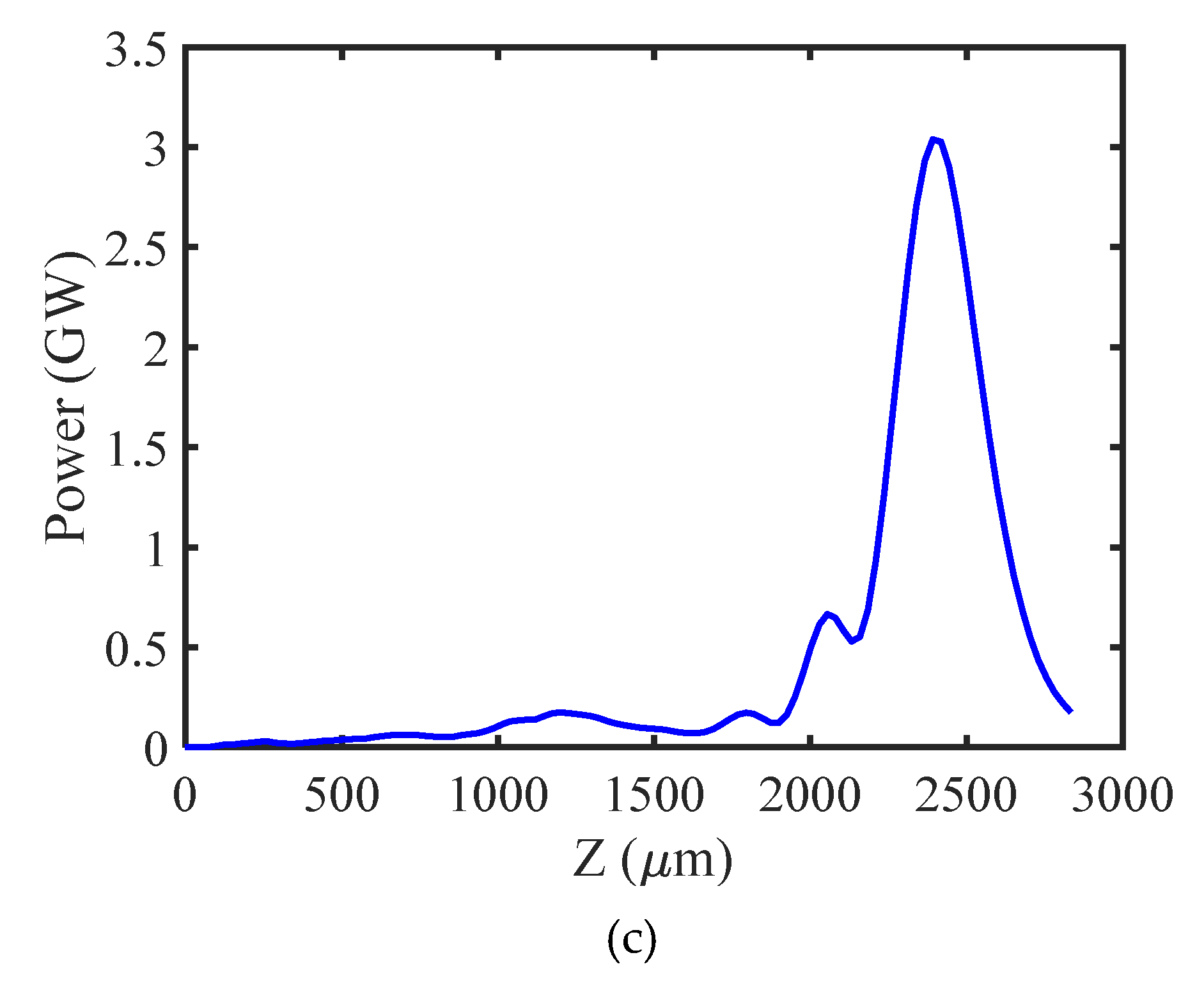
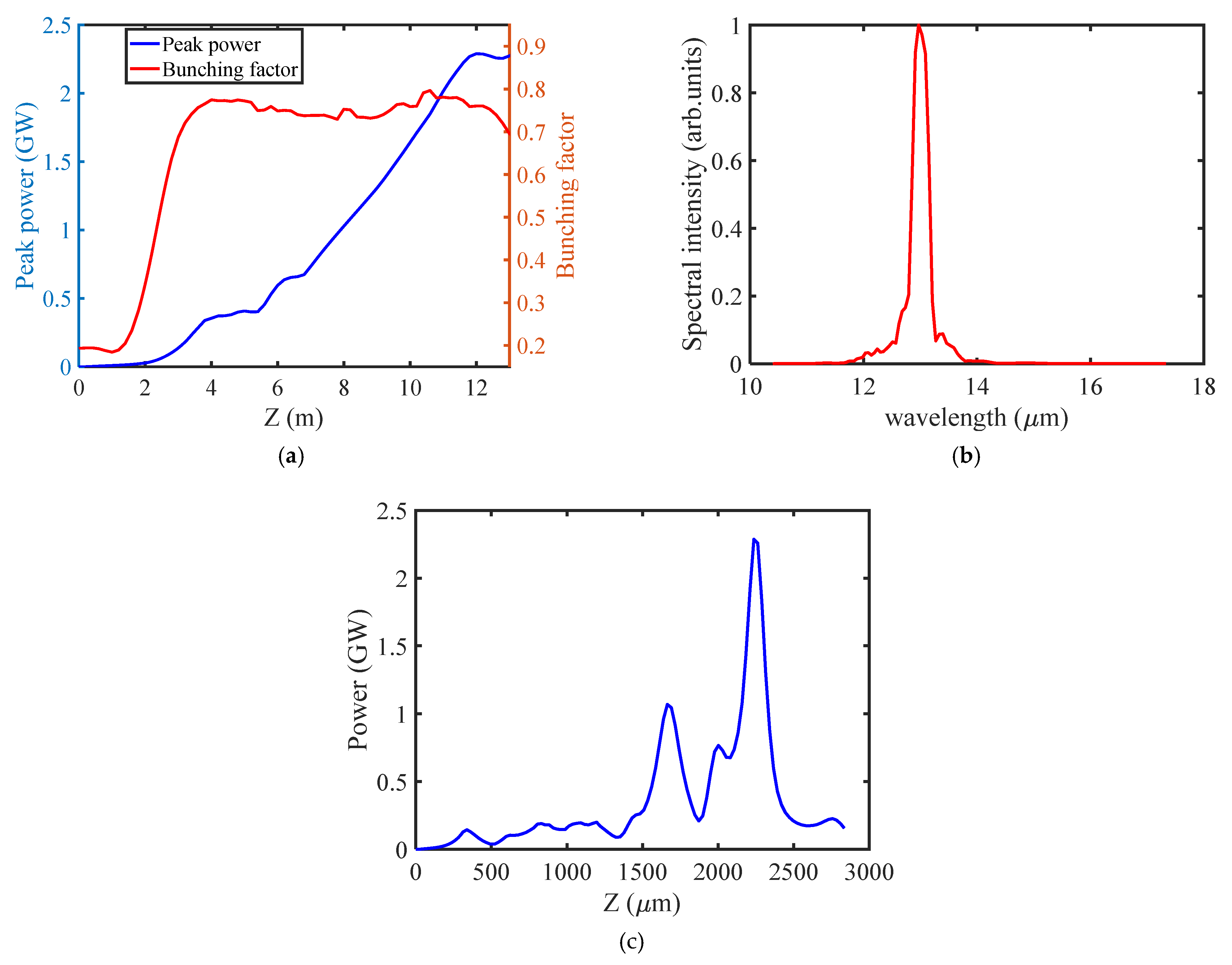
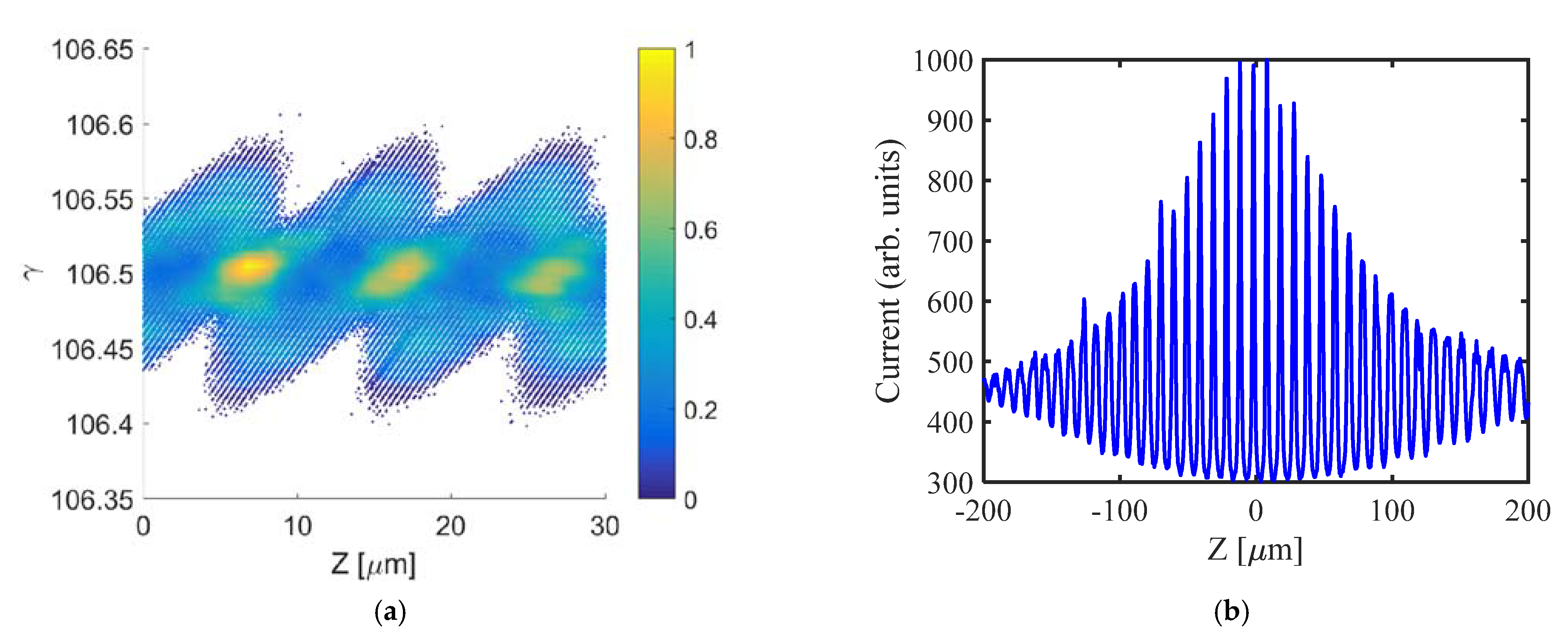

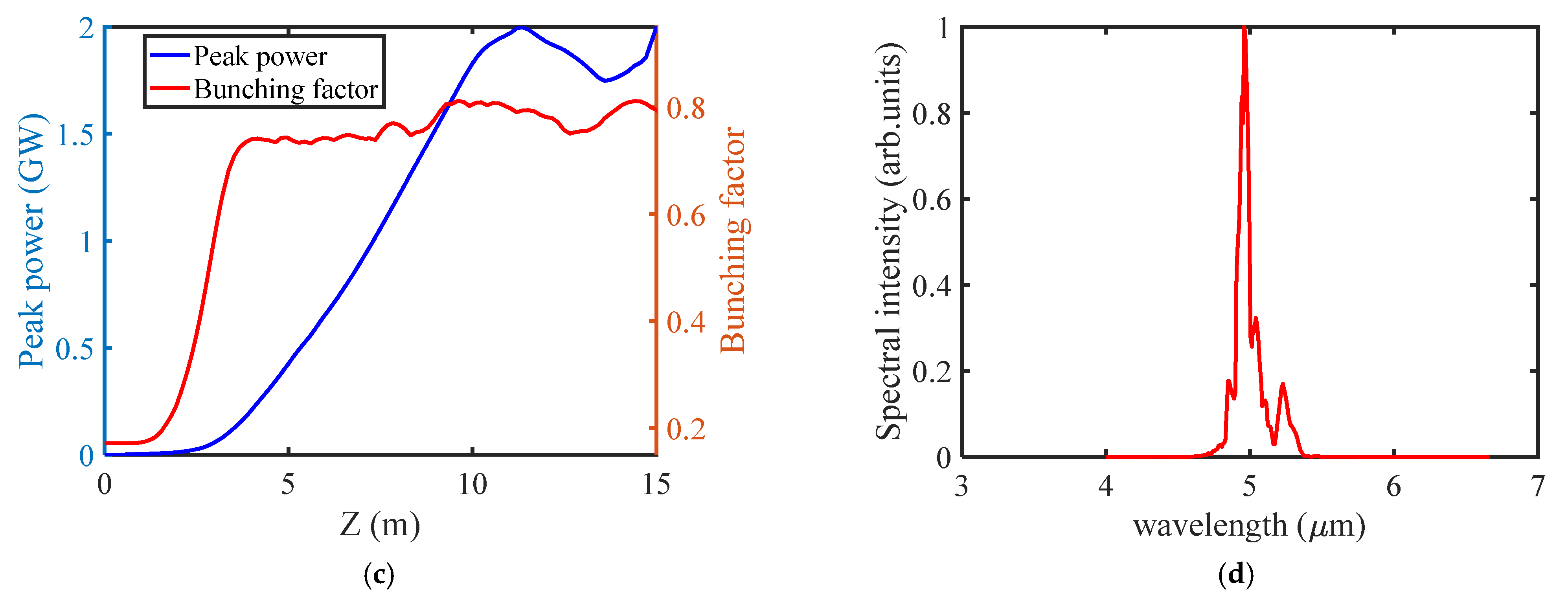


| Parameters | Value |
|---|---|
| Electron beam energy | 6–70 MeV |
| Energy spread (slice) | 0.01% |
| Peak current | ~520 A |
| Bunch length | 10 ps |
| Bunch charge | 4 nC |
| Normalized emittance | ~3.5 µm-rad |
| Seed laser wavelength | 800 nm |
| THz frequency | 0.1–100 THz |
| THz wavelength | 3 µm–3 mm |
| Undulator period | 10 cm |
Publisher’s Note: MDPI stays neutral with regard to jurisdictional claims in published maps and institutional affiliations. |
© 2021 by the authors. Licensee MDPI, Basel, Switzerland. This article is an open access article distributed under the terms and conditions of the Creative Commons Attribution (CC BY) license (https://creativecommons.org/licenses/by/4.0/).
Share and Cite
Zhang, K.; Kang, Y.; Liu, T.; Wang, Z.; Feng, C.; Fang, W.; Zhao, Z. A Compact Accelerator-Based Light Source for High-Power, Full-Bandwidth Tunable Coherent THz Generation. Appl. Sci. 2021, 11, 11850. https://doi.org/10.3390/app112411850
Zhang K, Kang Y, Liu T, Wang Z, Feng C, Fang W, Zhao Z. A Compact Accelerator-Based Light Source for High-Power, Full-Bandwidth Tunable Coherent THz Generation. Applied Sciences. 2021; 11(24):11850. https://doi.org/10.3390/app112411850
Chicago/Turabian StyleZhang, Kaiqing, Yin Kang, Tao Liu, Zhen Wang, Chao Feng, Wencheng Fang, and Zhentang Zhao. 2021. "A Compact Accelerator-Based Light Source for High-Power, Full-Bandwidth Tunable Coherent THz Generation" Applied Sciences 11, no. 24: 11850. https://doi.org/10.3390/app112411850
APA StyleZhang, K., Kang, Y., Liu, T., Wang, Z., Feng, C., Fang, W., & Zhao, Z. (2021). A Compact Accelerator-Based Light Source for High-Power, Full-Bandwidth Tunable Coherent THz Generation. Applied Sciences, 11(24), 11850. https://doi.org/10.3390/app112411850






